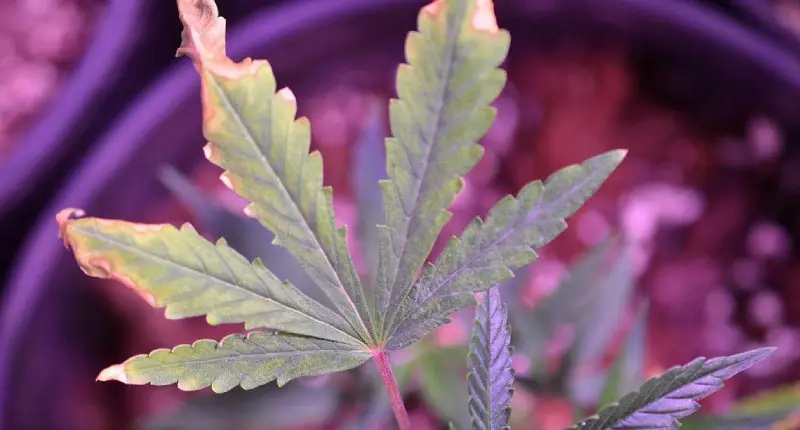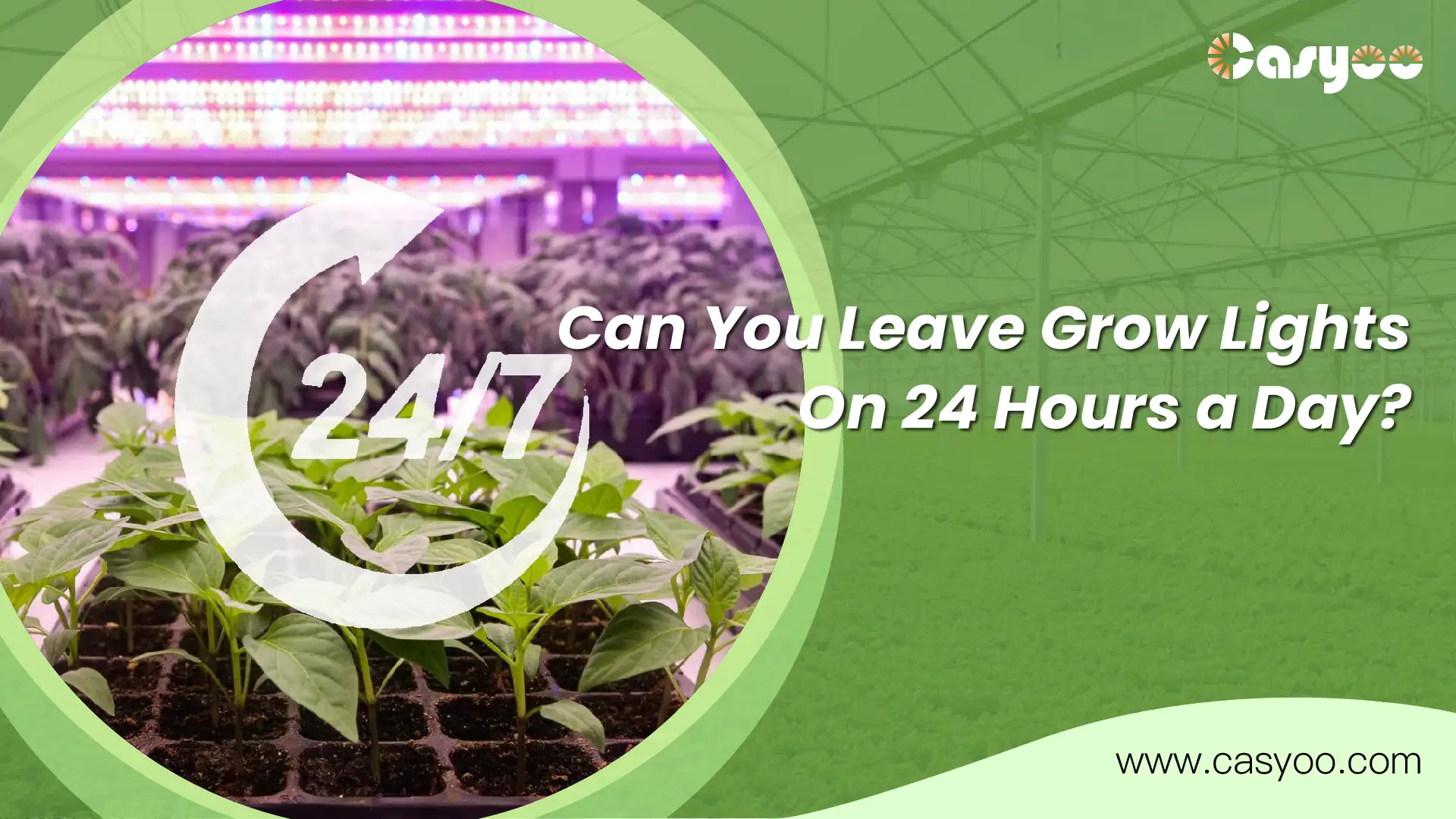Providing enough light to the plants in your grow space is essential. LED grow lights can extend your growing season and make your plants thrive. Some growers leave their grow lights on 24 hours a day because more light generally means more growth and more yields. There is no doubt that leaving your lights on longer will lead to faster growth. But does 24 hours of light really increase yields?
In this article, we will take a deep look at it. Can you leave your grow lights on 24/7? What effects do 24 hours of uninterrupted light have on your plants?
Can You Leave Grow Lights On 24 Hours A Day?
The quick answer is no. Plants cannot be exposed to 24 hours of light, be they long-day plants or short-day plants. It will have a negative impact on their growth.
Disadvantages of 24/7 Lighting
No Rest Time
The downside of 24/7 lighting is that your plants have no rest time. Undoubtedly, all-day light can make your plants grow faster. However, if you do this in the long term, your plants will become increasingly weaker and more susceptible to disease.
Plants also have a routine. During the day, plants photosynthesize carbon dioxide and light from the sun or artificial grow lights into sugars. At the same time, they release oxygen, and they are also breathing. When they are in the dark, they stop photosynthesizing and focus only on breathing. When they breathe, they convert the sugars they generated during the day into energy. They use this energy, as well as nutrients from the soil, to support their life.
Photooxidative Stress
Too much light will produce reactive oxygen species (ROS), damaging plant cells, and even causing cell death.
Decomposition of Chlorophyll
Excessive light can cause the decomposition of chlorophyll in the leaves, resulting in reduced photosynthetic capacity and slow growth.
Additional Costs
It costs more money to keep the lights on all day. You’ll need to pay for the electricity to power your grow lights, as well as the electricity to power fans, air conditioning, and any other equipment you might run in your growing space. You’ll also need to replace bulbs more frequently.
Additional Stress on Equipment
Leaving your lights on 24/7 also means that the grow lights and other equipment are always running, which puts stress on them and shortens their lifespan.
Additional Heat

Having your lights on all the time creates more heat. This means you’ll also need to run fans and other cooling equipment for 24 hours. Otherwise, your plants are at risk for burn.
Inefficient Water Use
Excessive light may also cause your crops to lose more water through transpiration, increasing the chance of drought.
Reduced Nutrients
All-day light can also damage the roots of your crops, which hinder their ability to absorb nutrients from the soil, thus thwarting plant development.
How Long Should Grow Lights Be On?
It mainly depends on the following factors:
- Plant Type
- Growth Stages
- Types of Grow Lights
Plant Type
Generally speaking, plants need about 12-16 hours of light per day to thrive, and some species will need more. Let’s check it.
- Tomatoes: 16 hours
- Cucumbers: 12 hours
- Peppers: 12-16 hours
- Marijuana: vegetative stage: 18-24 hours; flowering stage: 12 hours
- Succulents: 14-16 hours
- Herbs: 12-16 hours
- Lettuce: 12-14 hours
- Strawberries: 14-16 hours
Growth Stages
Strawberries
- Seedling stage: During this stage, strawberries require low to moderate light. It is best to have your grow lighting running for about 12-16 hours.
- Vegetative stage: Strawberries require higher light levels in this stage. 14-18 hours of light per day is advised.
- Flowering stage: Strawberries need more light at this stage. It’s best to provide them with 16-18 hours of light.
- Fruiting stage: Strawberries, eager to enter the fruiting stage, need moderate to high light intensity. 12-14 hours of light is advised.
As your strawberries grow, it is vital to monitor them and adjust your LED grow lights. This includes adjusting light intensity and the mounting height. Wild strawberries and June strawberries have various light requirements. Please check their specific light requirement carefully.
Succulents
- Seeding stage: Succulents require direct bright light to successfully germinate. A succulent grow light with an intensity of 200-400µmol/m²/s and a color temperature of 5000K-6500K is suitable for this phase.
- Vegetative stage: Grow lights with an intensity of 400-600µmol/m²/s and color temperature of 5000K-6500K are best.
- Flowering stage: Succulents require the most intense light during this phase. A grow light with an intensity of 600-800µmol/m²/s and a color temperature of 2700K-3000K is ideal for this phase.
Some types of succulents can tolerate less light. It’s best to check the specific needs to ensure they get enough light. For their health, make sure your succulents aren’t exposed to too much direct sunlight. If you notice any signs of burns, such as brown spots or leaf burns, you may need to move your succulents to a slightly shadier location.
Case study
A study showed that compared with 12 hours of light, the weight of tomato stems increased by 80% and the weight of roots increased by about 100% under 16 hours of light. But this does not mean that longer light exposure is better for plant growth. The light time suitable for tomatoes is 16-20 hours, and continuous 24 hours of lighting will lead to reduced photosynthetic capacity and slow growth. In addition, 24 hours of lighting also increases energy consumption and costs.
How to tell if plants are getting too much light?
- Leaf changes
If you notice burns and yellowing on the leaves, it means the light exposure time is too long. Too much light can cause chlorophyll decomposition or photooxidative stress, and the leaves will appear burnt, dry, yellow or white.
- Internode length
Excessive or reduced internodal elongation Internode length may be due to too long light exposure time. This is because too much light causes plant hormone imbalance and inhibits the normal growth of plants.
- Root development
Without enough dark periods, plants cannot absorb enough nutrients, and the roots of plants will become shallow or even rot.
- Other growth abnormalities
If you find that your plant’s growth is basically stagnant or the leaves are curling or wilting, it may be caused by too long light exposure time.
Smart Lighting Solutions for Plant Care
If you want to keep your plant lights on 24 hours a day just because you don’t have time to take care of them, you can try smart grow lights. The timers and automatic control systems in these lights can accurately execute 18/6 or 20/4 cycles, so you don’t have to worry about it anymore. Lamps with light sensors can also detect light intensity and spectral distribution in real time, and adjust the lighting plan according to the light cycle requirements.
Final Thoughts
Keeping your grow lights on 24/7 will increase the amount of light your crops receive, which can speed up growth. But your plants will be damaged and more susceptible to disease. It also increases additional costs.
If you want to increase the amount of light, you should buy additional grow lights or replace your current lights with more powerful ones. This will give you better outcomes than if you just left the lights on all the time. And I recommend Casyoo LED grow lights. Talk to us!




